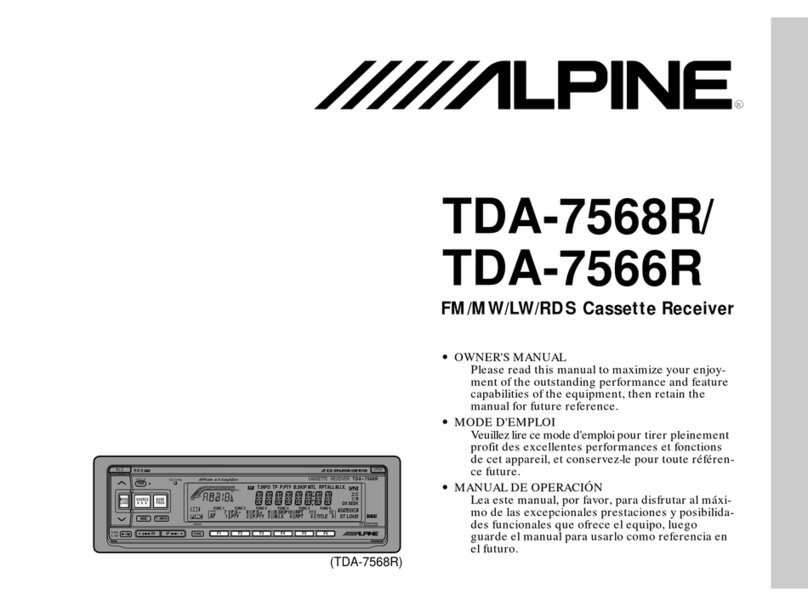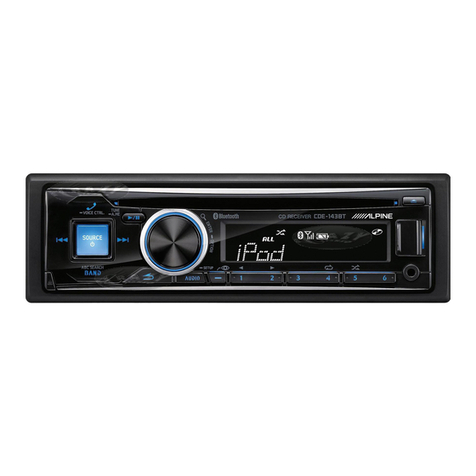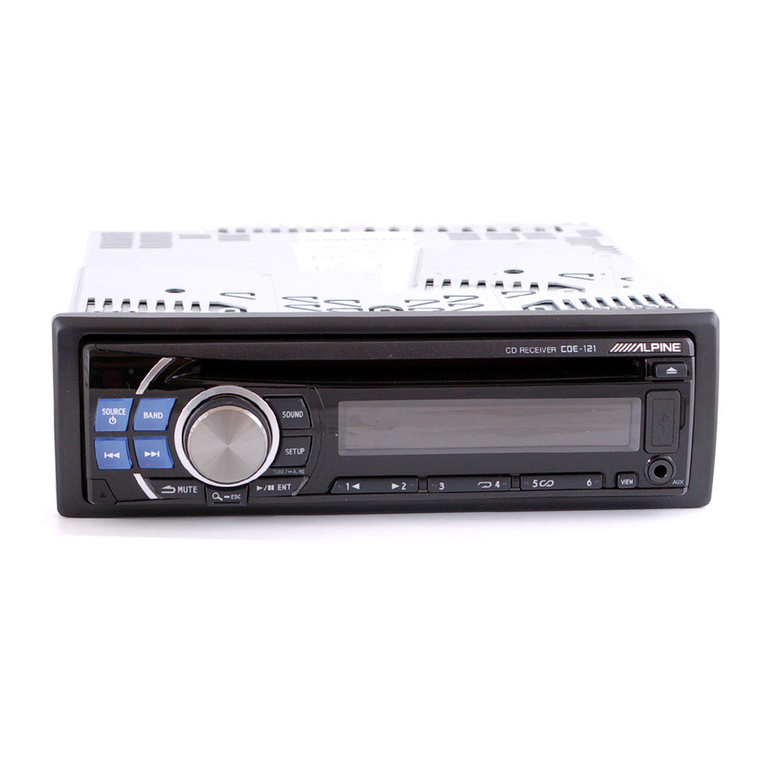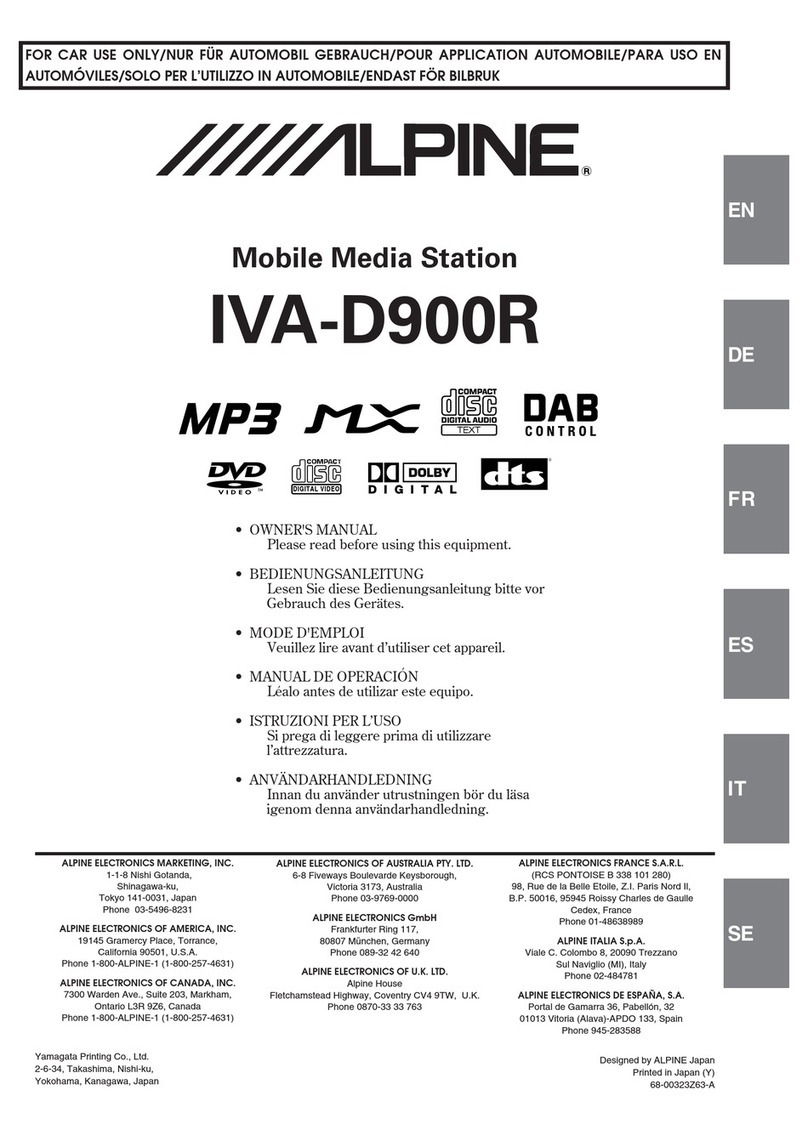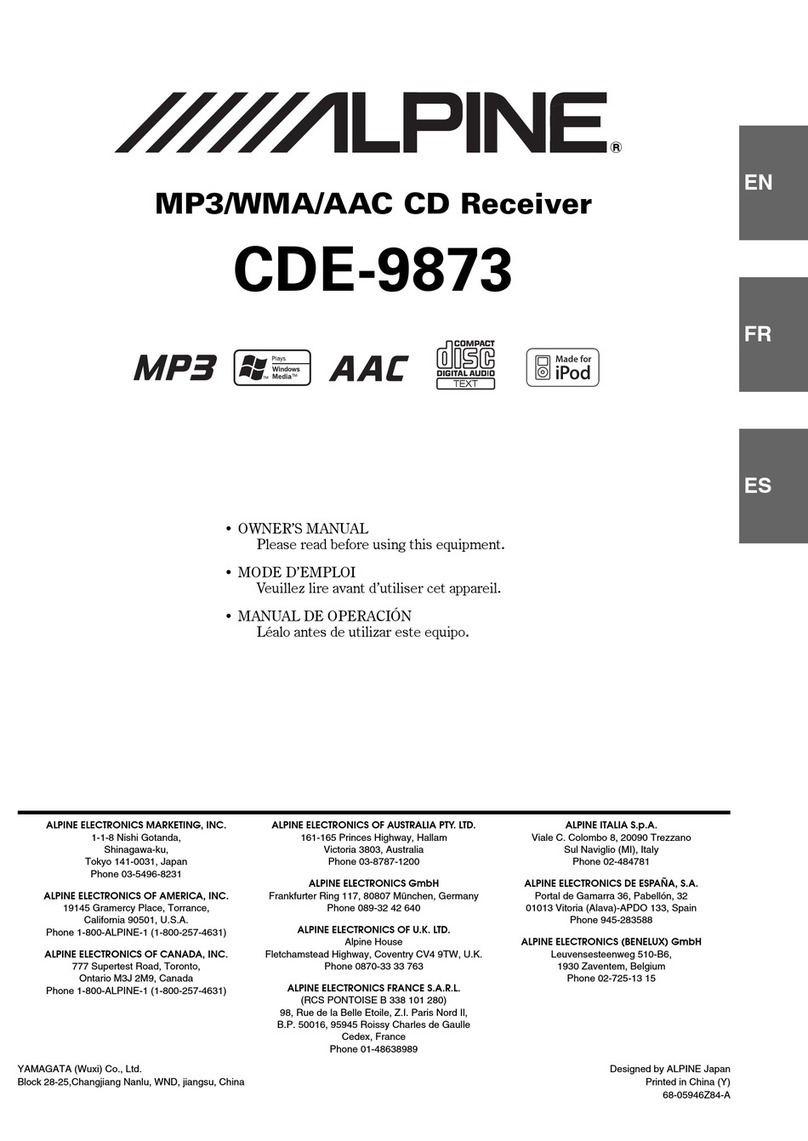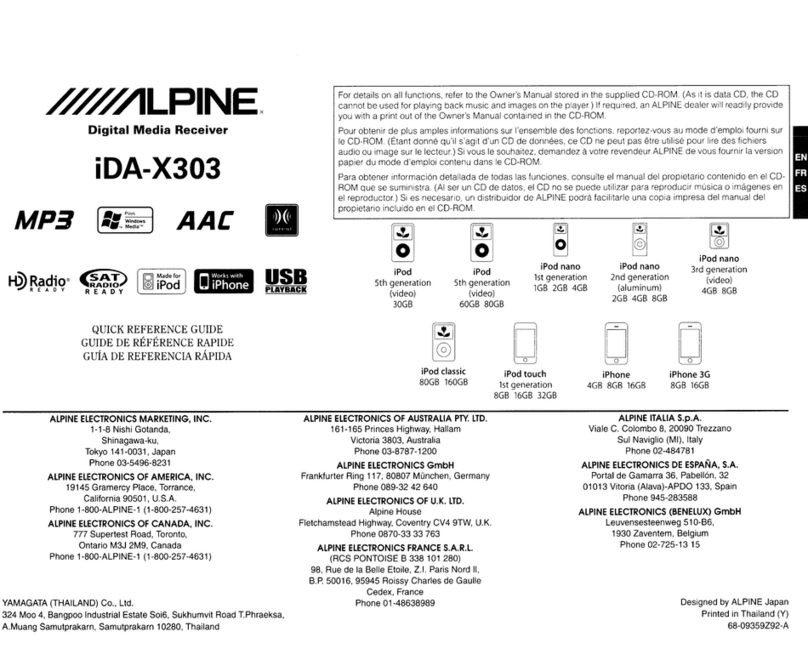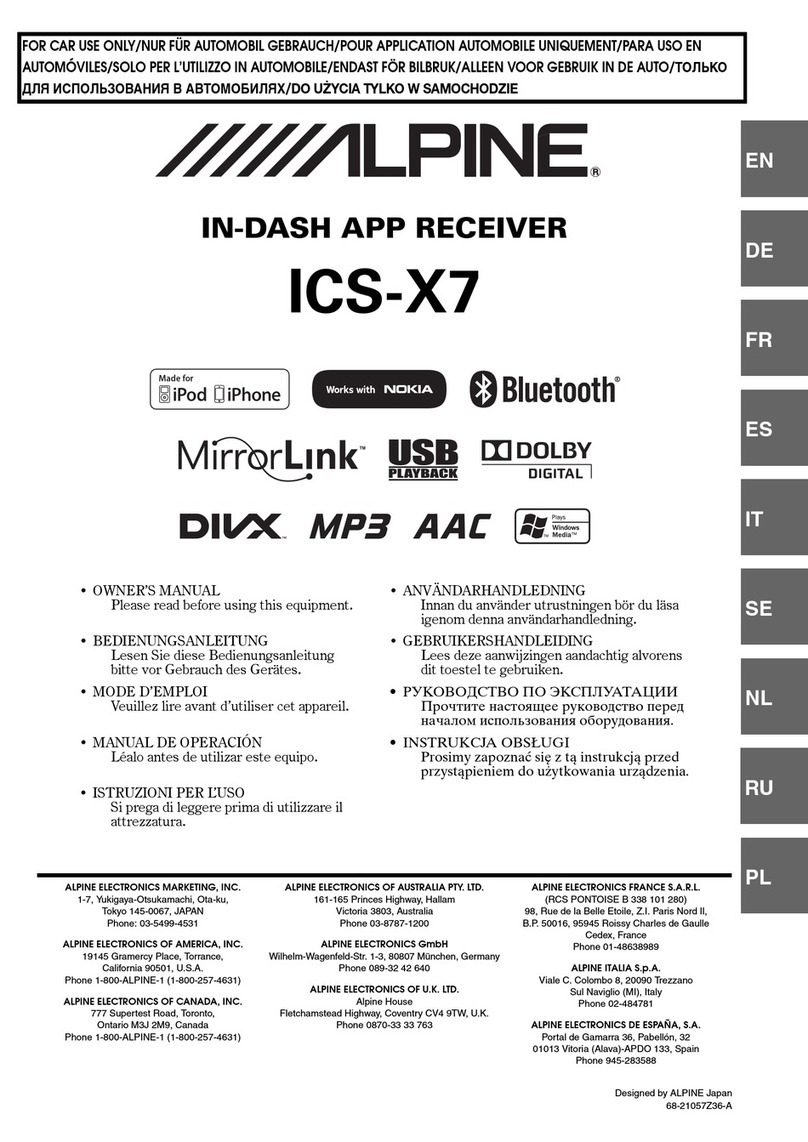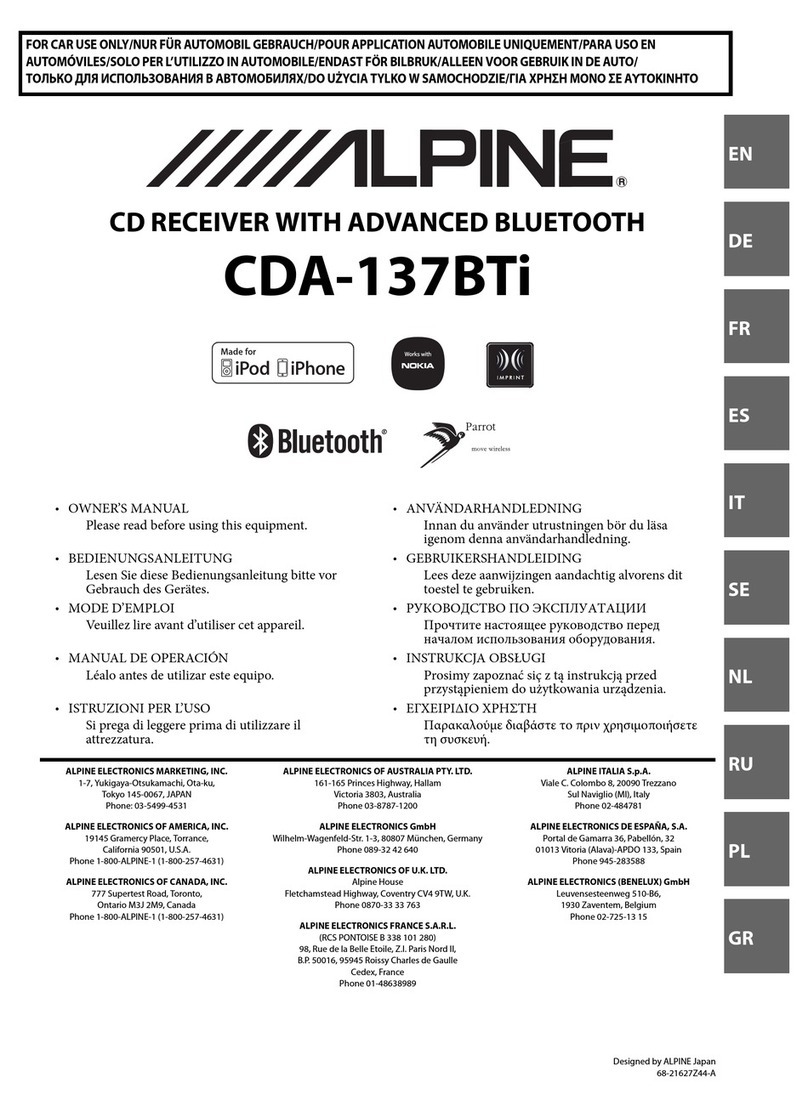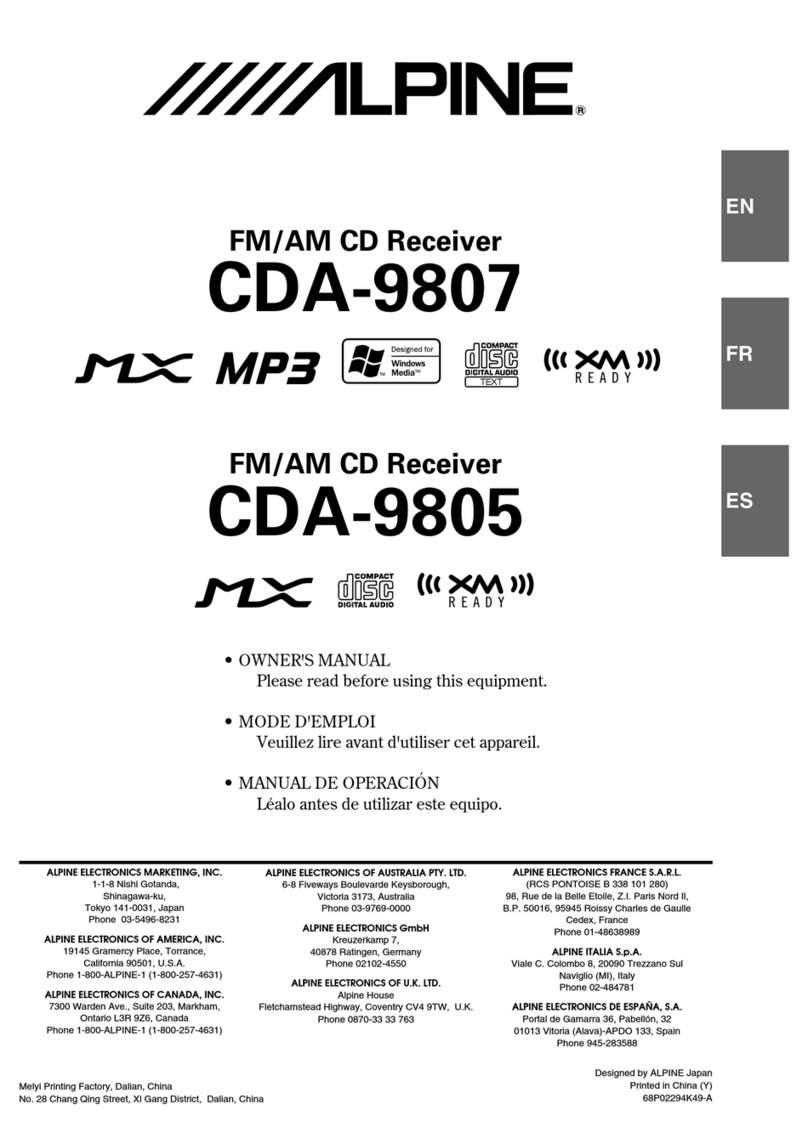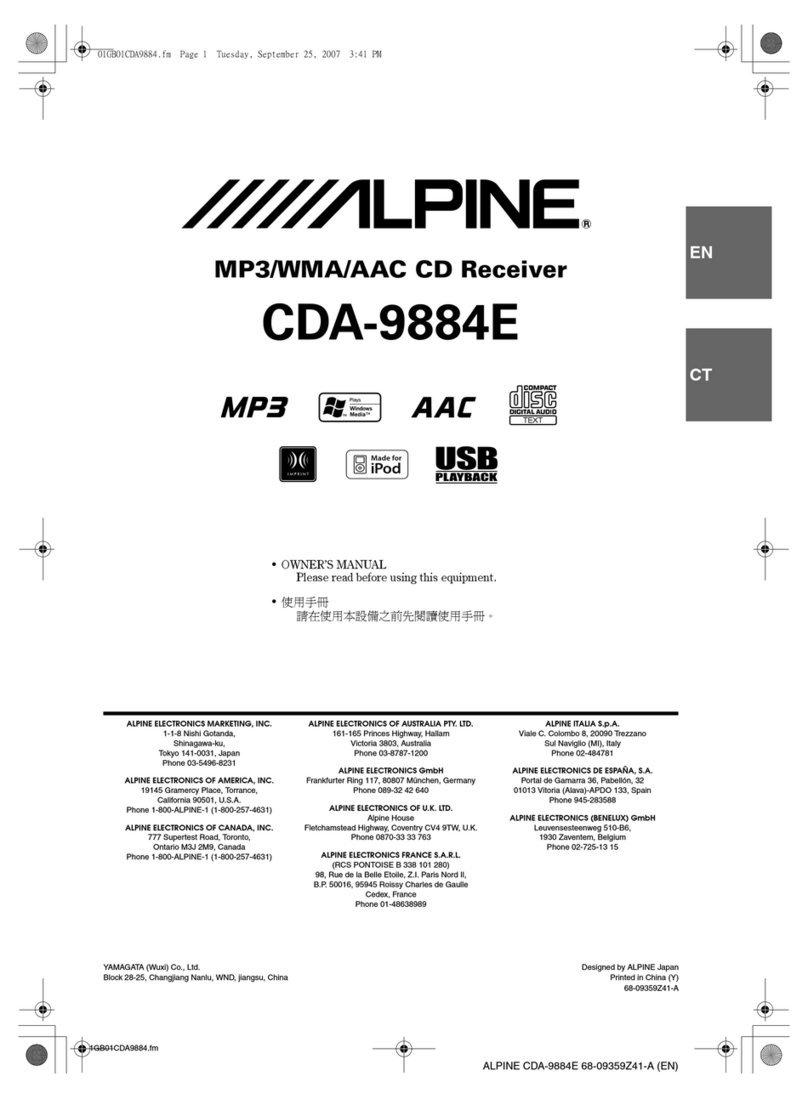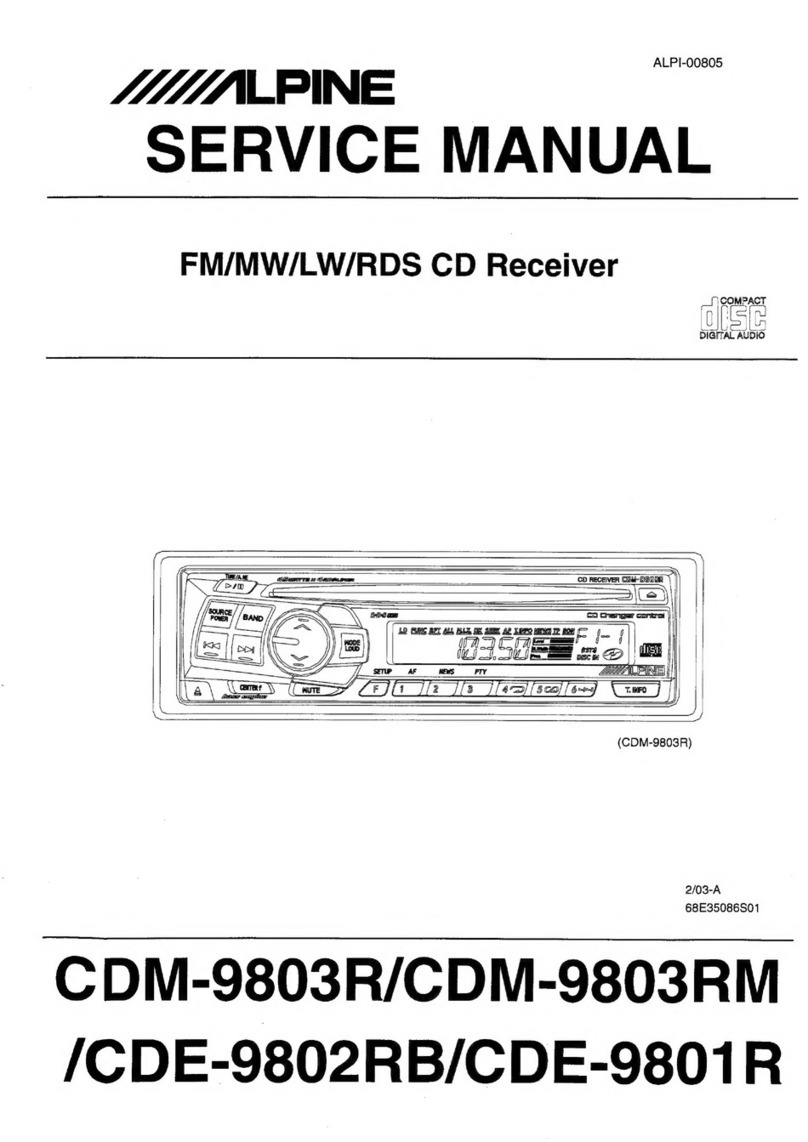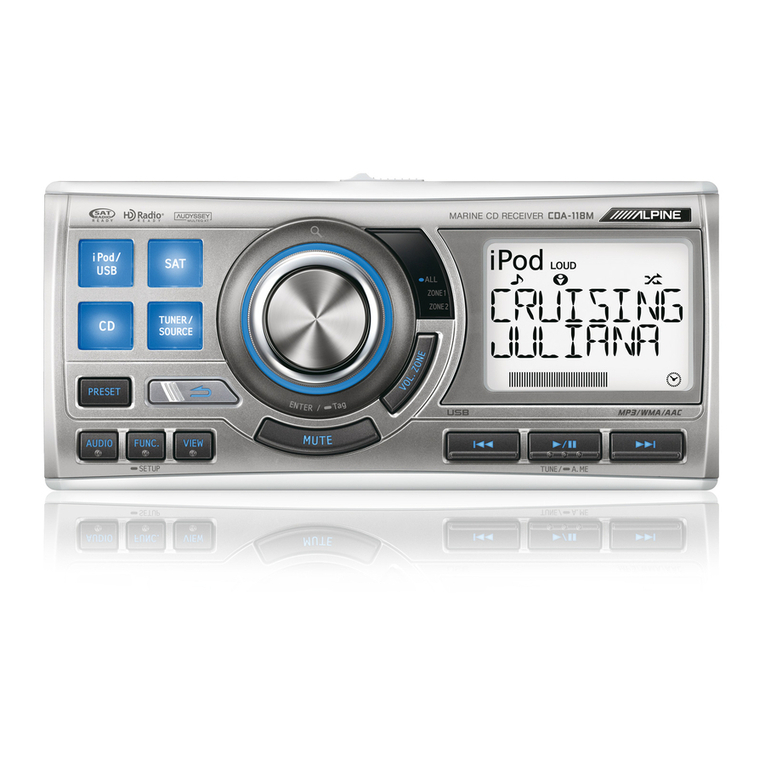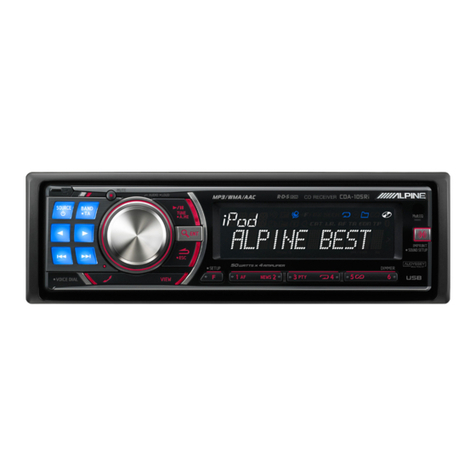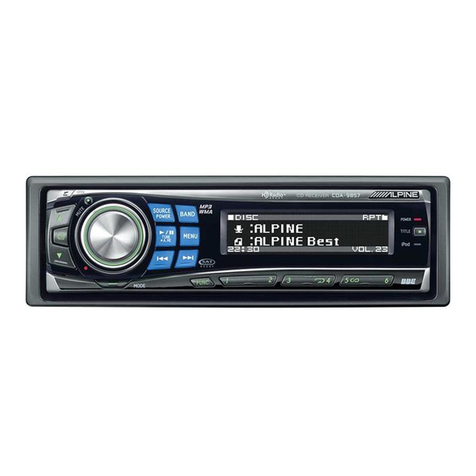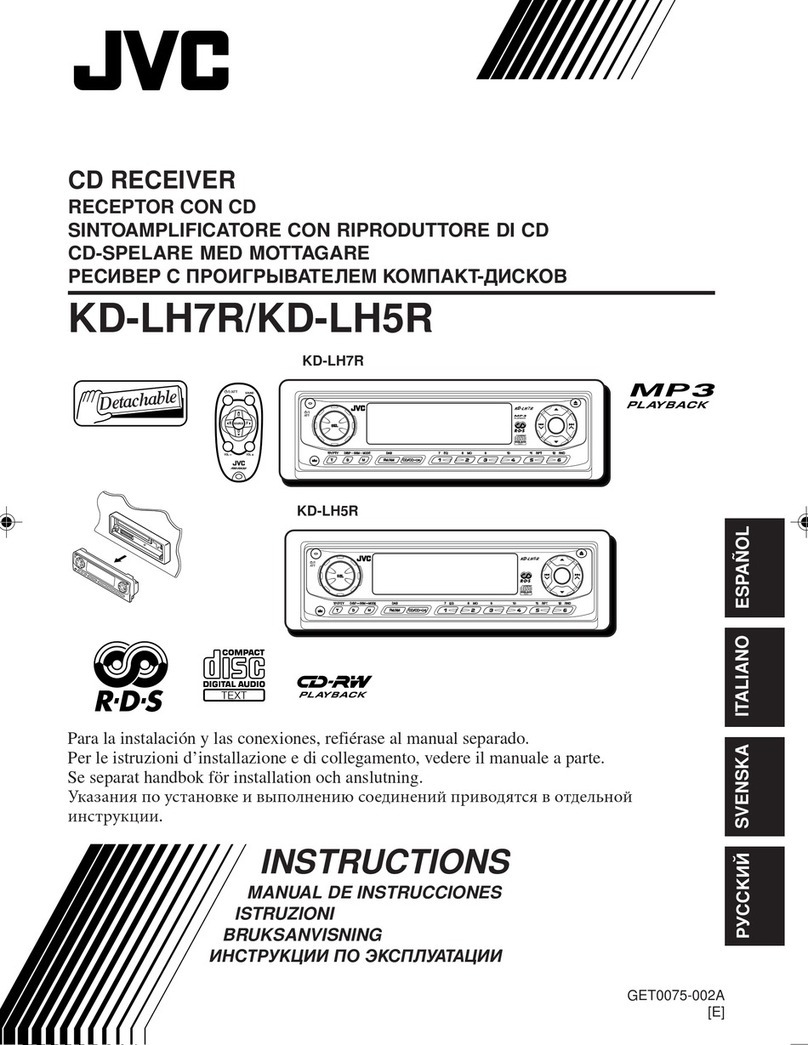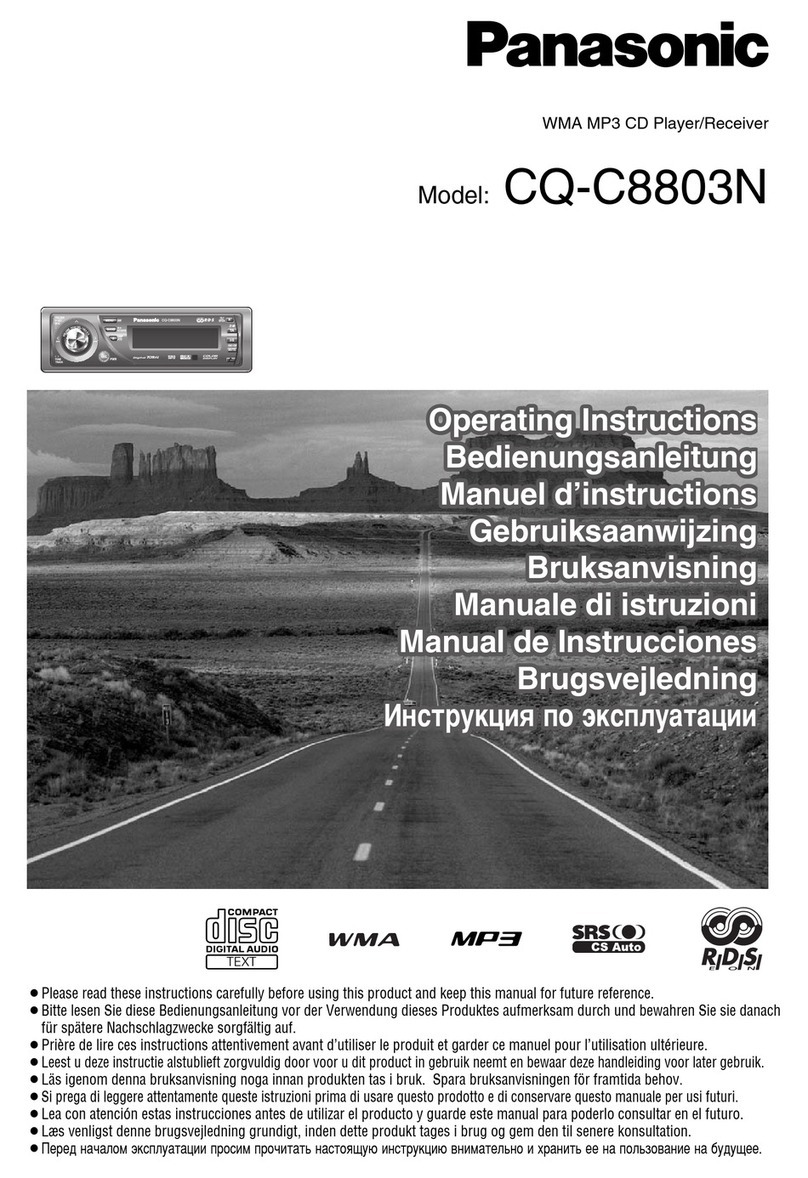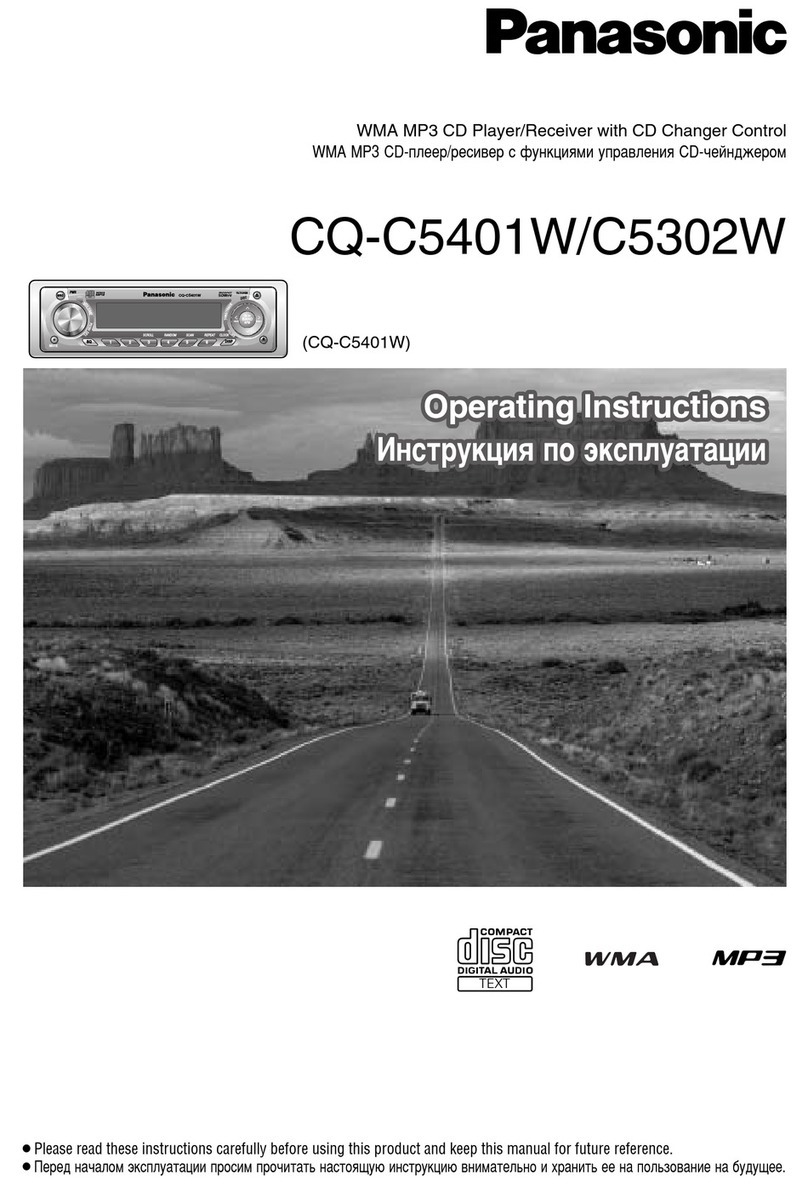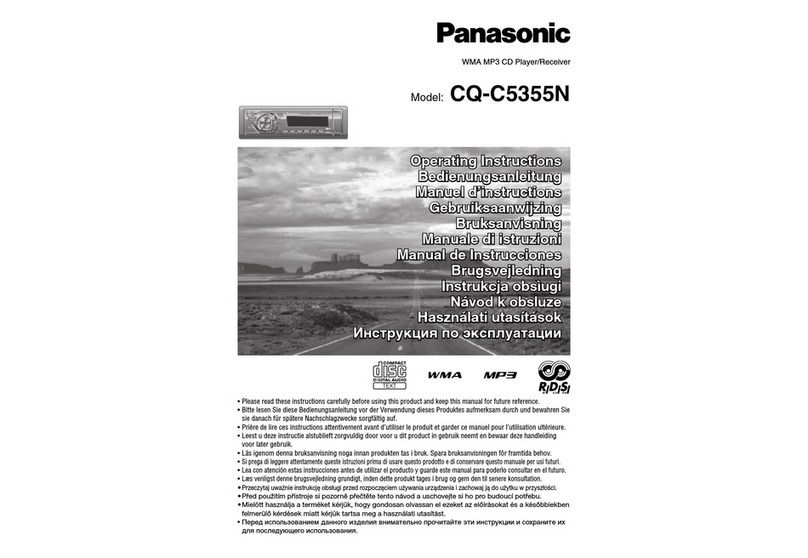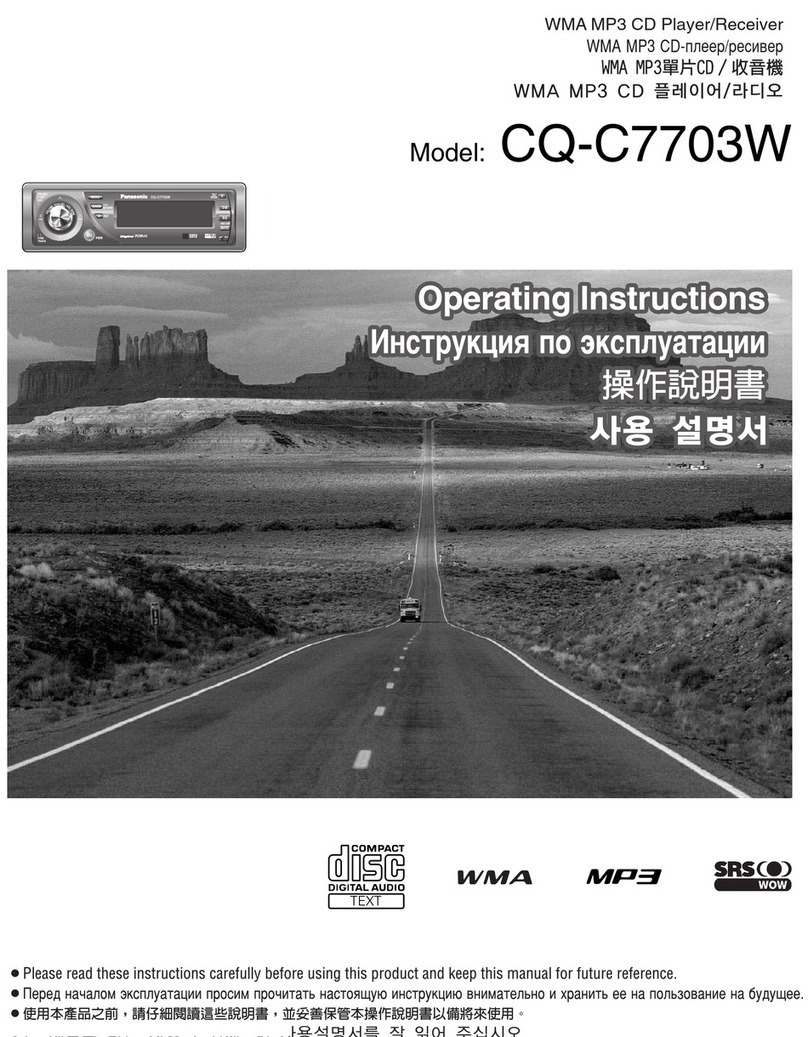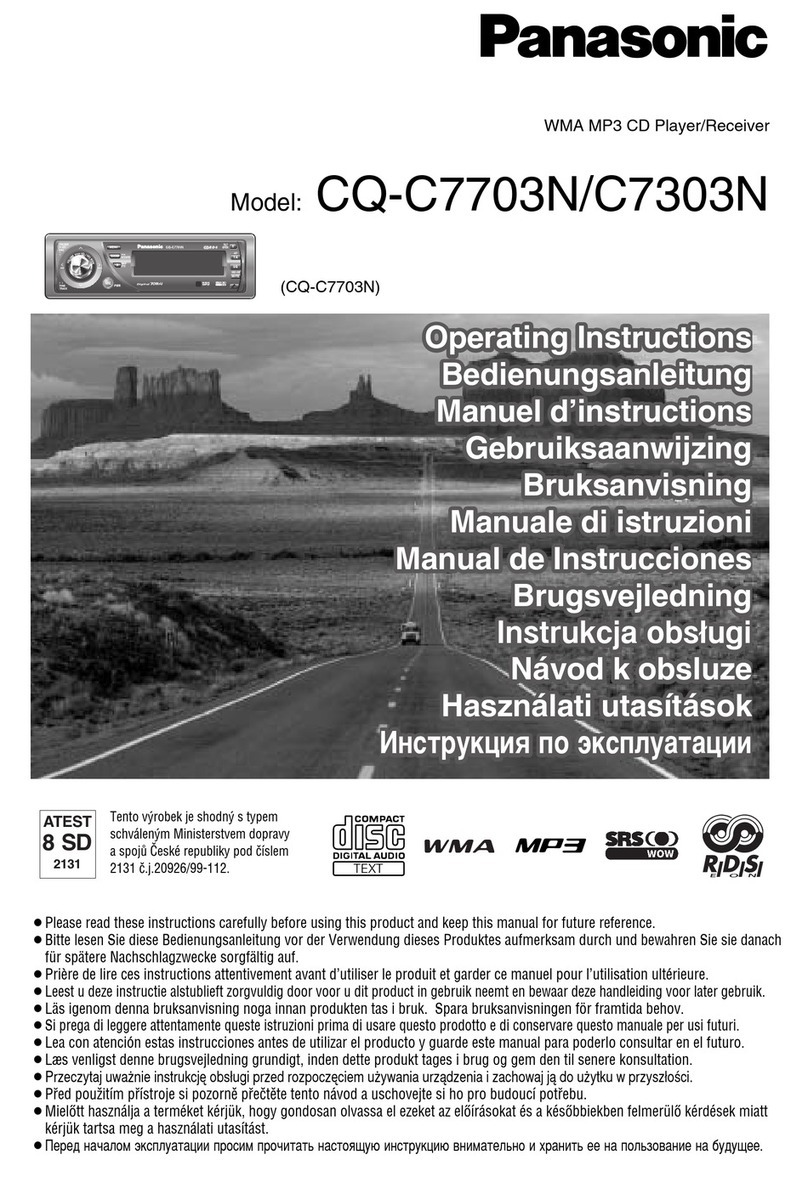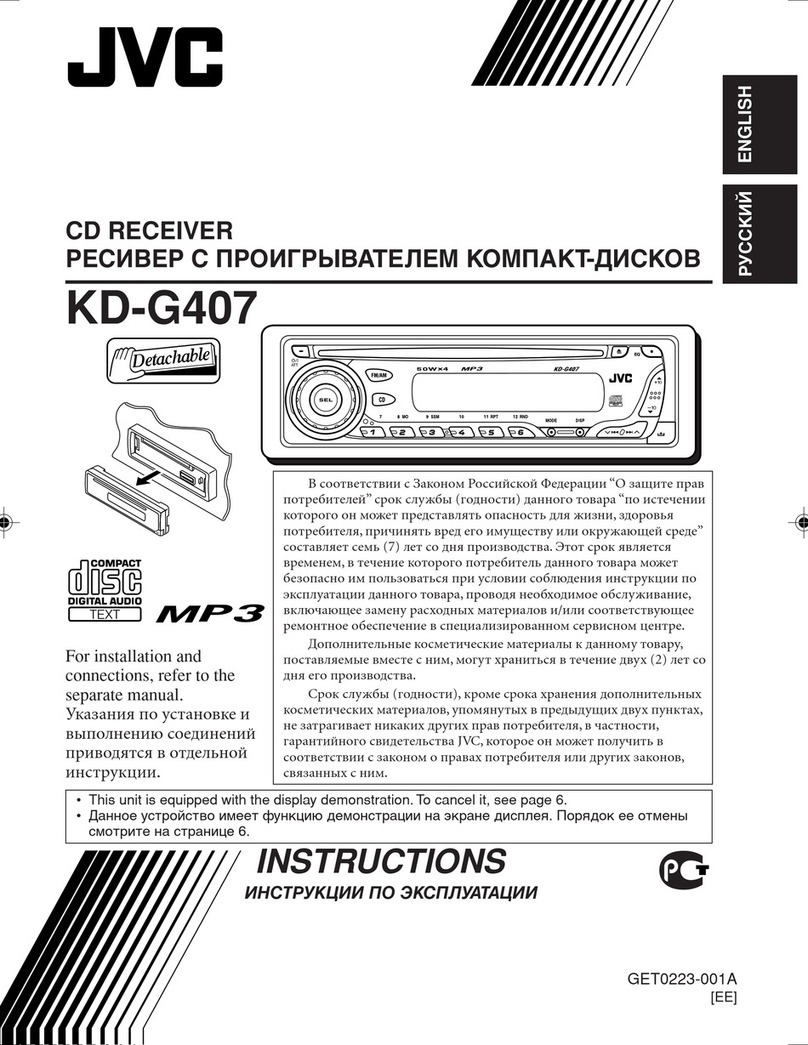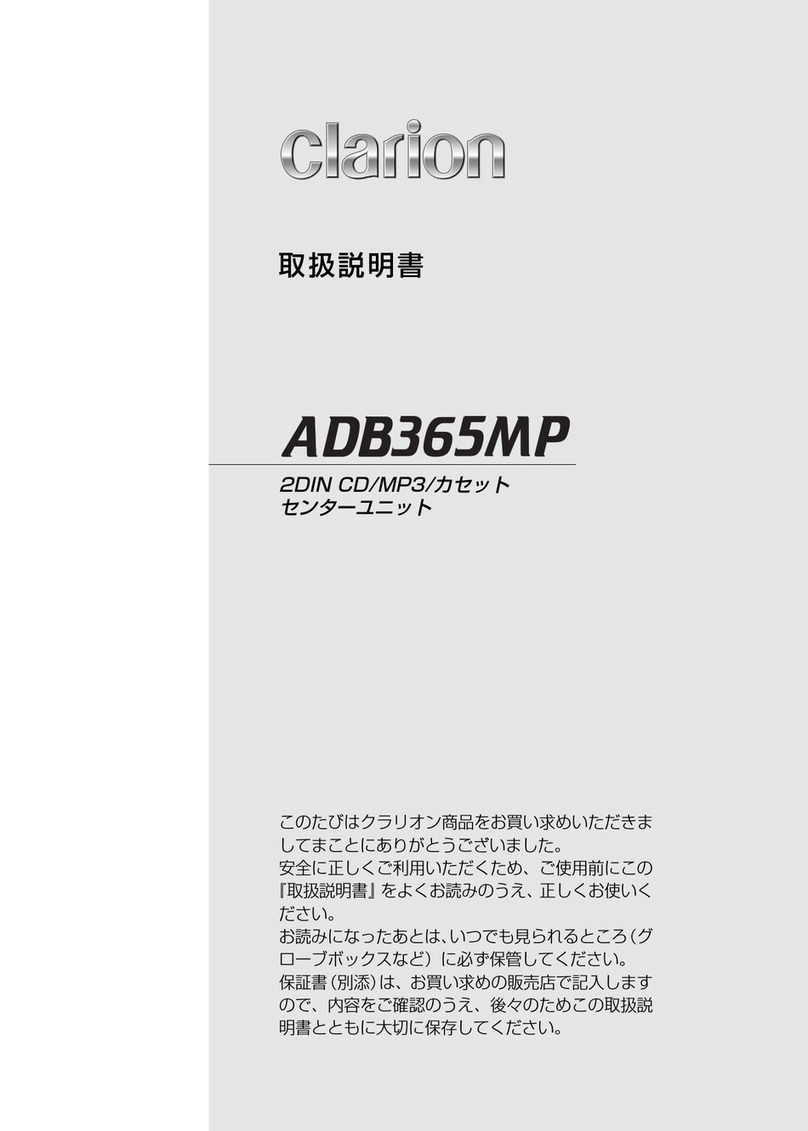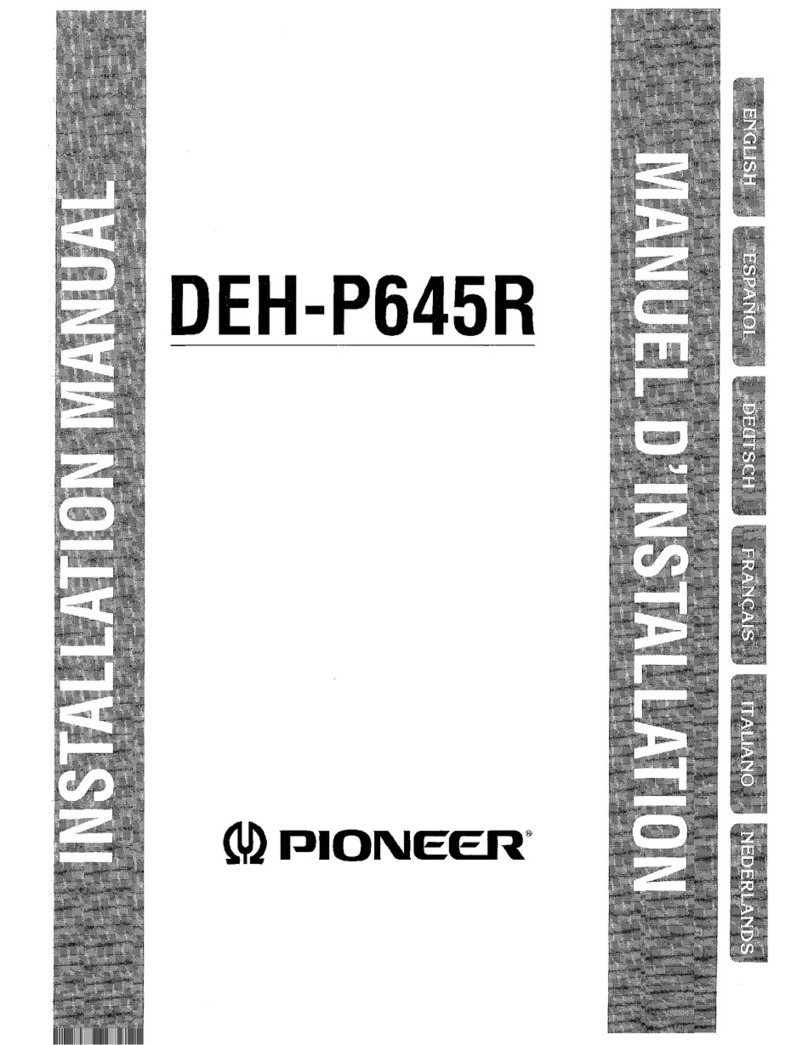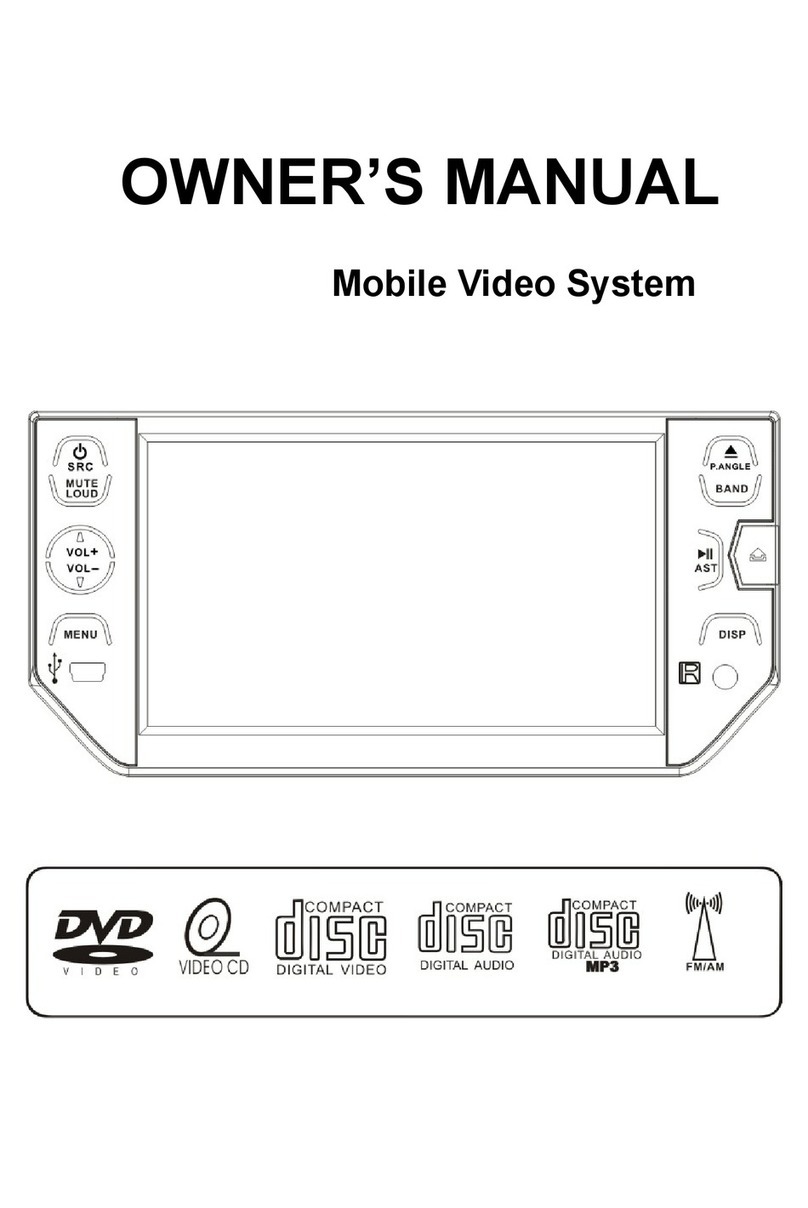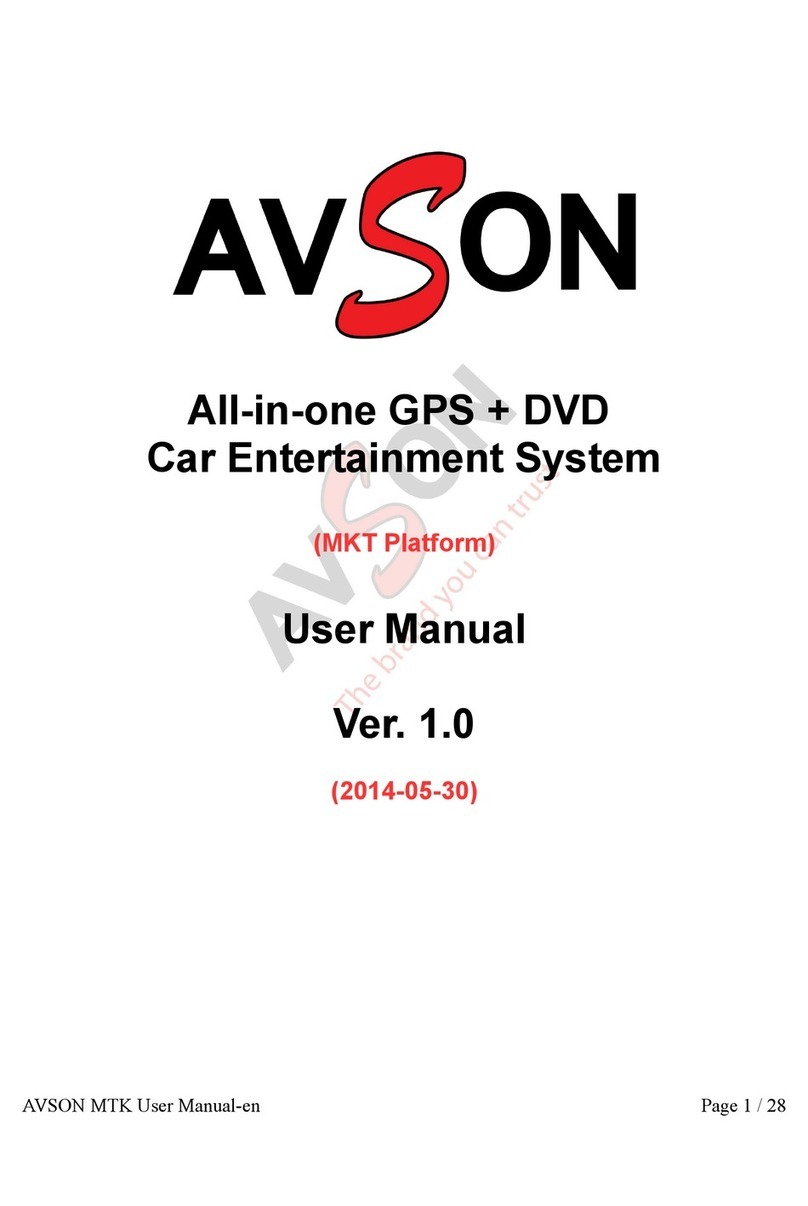EN
12345
678910
FORCAR USEONLY/NURFÜR AUTOMOBILGEBRAUCH/POUR APPLICATIONAUTOMOBILEUNIQUEMENT/PARAUSOEN
AUTOMÓVILES/SOLOPER L’UTILIZZOIN AUTOMOBILE/ENDASTFÖR BILBRUK/ALLEENVOOR GEBRUIKIN DE AUTO/
MP3 CD Receiver
CDE-120R / CDE-120RM /
CDE-120RR
•OWNER’S MANUAL
Please read before using this product.
•BEDIENUNGSANLEITUNG
Lesen Sie diese Bedienungsanleitung bitte vor
Gebrauch des Gerätes.
•MODE D’EMPLOI
Veuillezlire avant d’utiliser cet appareil.
•MANUAL DE OPERACIÓN
Léalo antes de utilizar este equipo.
•ISTRUZIONI PER L’USO
Si prega di leggere prima di utilizzare il
attrezzatura.
•ANVÄNDARHANDLEDNING
Innan du använder utrustningen bör du läsa
igenom denna användarhandledning.
•GEBRUIKERSHANDLEIDING
Lees deze aanwijzingen aandachtig alvorens dit
toestel te gebruiken.
ALPINE ELECTRONICS GmbH
Wilhelm-Wagenfeld-Straße1-3,
80807 München, Germany
Phone 089-32 42 640
ALPINE ELECTRONICS OF U.K., LTD.
ALPINE House
Fletchamstead Highway,
Coventry CCV4 9TW, U.K.
Phone 0870-33 33 763
ALPINE ELECTRONICS FRANCE S.A.R.L.
(RCS PONTOISE B 338 101 280)
98, Rue de la Belle Etoile, Z.I. Paris Nord II,
B.P.50016, 95945 Roissy Charles de Gaulle
Cedex, France
Phone 01-48638989
ALPINE ITALIAS.p.A.
Viale C. Colombo 8, 20090Trezzano
Sul Naviglio (MI), Italy
Phone 02-484781
ALPINE ELECTRONICS DE ESPAÑA,S.A.
Portal de Gamarra 36, Pabellón, 32
01013 Vitoria (Alava)-APDO 133, Spain
Phone 945-283588
ALPINE ELECTRONICS (BENELUX) GmbH
Leuvensesteenweg510-B6,
1930 Zaventem, Belgium
Phone 02-725 1315
R
Operating Instructions
DO NOT OPERATEANY FUNCTION THAT TAKES
YOUR ATTENTION AWAY FROMSAFELY DRIVING
YOUR VEHICLE.
Any function that requires your prolonged attention should only be
performed after coming to a complete stop. Always stop the vehicle
in a safe location before performing these functions. Failure to do
so may result in an accident.
KEEP THE VOLUME AT A LEVELWHERE YOU CAN
STILL HEAR OUTSIDE NOISES WHILE DRIVING.
Excessive volume levels that obscure sounds such as emergency
vehicle sirens or road warning signals (train crossings, etc.) can be
dangerous and may result in an accident. LISTENING AT LOUD
VOLUME LEVELS IN A CAR MAY ALSO CAUSE HEARING
DAMAGE.
MINIMIZE DISPLAY VIEWING WHILE DRIVING.
Viewing the display may distract the driver from looking ahead of
the vehicle and cause an accident.
DO NOT DISASSEMBLE OR ALTER.
Doing so may result in an accident, fire or electric shock.
USE ONLYIN CARS WITH A 12 VOLT NEGATIVE
GROUND.
(Check with your dealer if you are not sure.) Failure to do so may
result in fire, etc.
KEEP SMALL OBJECTS SUCH AS BATTERIES OUT
OF THE REACH OF CHILDREN.
Swallowing them may result in serious injury. If swallowed,
consult a physician immediately.
USE THE CORRECT AMPERE RATING WHEN
REPLACING FUSES.
Failure to do so may result in fire or electric shock.
DO NOT BLOCK VENTS OR RADIATOR PANELS.
Doing so may cause heat to build up inside and may result in fire.
USE THIS PRODUCT FOR MOBILE 12V
APPLICATIONS.
Use for other than its designed application may result in fire,
electric shock or other injury.
DO NOT PLACE HANDS, FINGERS OR FOREIGN
OBJECTS IN INSERTION SLOTS OR GAPS.
Doing so may result in personal injury or damage to the product.
HALT USE IMMEDIATELYIF A PROBLEM APPEARS.
Failure to do so may cause personal injury or damage to the
product. Return it to your authorized Alpine dealer or the nearest
AlpineServiceCentre for repairing.
PRECAUTIONS
Product Cleaning
Use a soft dry cloth for periodic cleaning of the product. For more
severe stains, please dampen the cloth with water only. Anything
else has the chance of dissolving the paint or damaging the plastic.
Temperature
Be sure the temperature inside the vehicle is between +55°C
(+131°F) and –10°C (+14°F) before turning your unit on.
Moisture Condensation
Youmay notice the CD playback sound wavering due to
condensation. If this happens, remove the disc from the player and
wait about an hour for the moisture to evaporate.
Damaged Disc
Do not attempt to play cracked, warped, or damaged discs. Playing
a bad disc could severely damage the playback mechanism.
Maintenance
If you have problems, do not attempt to repair the unit yourself.
Return it to your Alpine dealer or the nearest Alpine Service
Station for servicing.
WARNING
WARNING
This symbol means important instructions.
Failure to heed them can result in serious injury
or death.
CAUTION
This symbol means important instructions.
Failure to heed them can result in injury or
material property damage.
NeverAttempt the Following
Do not grip or pull out the disc while it is being pulled back into the
player by the automatic reloading mechanism.
Do not attempt to insert a disc into the unit when the unit power is
off.
Inserting Discs
Yourplayer accepts only one disc a t a time for playback. Do not
attempt to load more than one disc.
Make sure the label side is facing up when you insert the disc.
Playing a disc while driving on a very bumpy road may result in
skips, but this will not scratch the disc or damage the player.
New Discs
To prevent the CD from jamming, the LCD is displayed as error if
discs with irregular surfaces are inserted or if discs are inserted
incorrectly. When a new disc is ejected immediately after initial
loading, use your finger to feel around the inside of the centre hole
and outside edge of the disc. If you feel any small bumps or
irregularities, this could inhibit proper loading of the disc. To
remove the bumps, rub the inside edge of the hole and outside edge
of the disc with a ballpoint pen or other such instrument, then insert
the disc again.
Irregular Shaped Discs
Be sure to use round shape discs only for this unit and never use
any special shape discs.
Use of special shape discs may cause damage to the mechanism.
Installation Location
Make sure this unit will not be installed in a location subjected to:
•Direct sun and heat
•High humidity and water
•Excessive dust
•Excessivevibrations
Correct Handling
Do not drop the disc while handling. Hold the disc so you will not
leave fingerprints on the surface. Do not affix tape, paper, or
gummed labels to the disc. Do not write on the disc.
Disc Cleaning
Fingerprints, dust, or soil on the surface of the disc could cause the
CD player to skip. For routine cleaning, wipe the playing surface
with a clean, soft cloth from the centre of the disc to the outer edge.
If the surface is heavily soiled, dampen a clean, soft cloth in a
solution of mild neutral detergent before cleaning the disc.
Disc Accessories
There are various accessories available on the market for protecting
the disc surface and improving sound quality. However, most of
them will influence the thickness and/or diameter of the disc. Using
such accessories can cause the disc to be out of standard
specifications and may create operational problems. We
recommend not using these accessories on discs played in Alpine
CD players.
Centre Hole
Bumps
Centre HoleNew Disc
Outside
(Bumps)
CORRECT
INCORRECTCORRECT
Transparent Sheet Disc Stabilizer
On handling CompactDiscs (CD/CD-R/CD-RW)
•Do not touch the surface.
•Do not expose the disc to direct sunlight.
•Do not affix stickers or labels.
•Clean the disc when it is dusty.
•Make sure that there are no bumps around the disc.
•Do not use commercially available disc accessories.
Do not leave the disc in the car or the unit for a long time.
Never expose the disc to direct sunlight. Heat and humidity may
damage the CD and you may not be able to play it again.
To customers using CD-R/CD-RW
•If a CD-R/CD-RW cannot be played back, make sure the last
recording session was closed (finalized).
•Finalize the CD-R/CD-RW if necessary,and a ttempt playback
again.
About media that can be played
Use only compact discs with the label side showing the CD logo
marks below.
If you use unspecified compact discs, correct performance cannot
be guaranteed.
Youcan play CD-Rs (CD-Recordables)/CD-RWs (CD-
ReWritables) which have been recorded only on audio devices.
Youcan also play CD-Rs/CD-RWs containing MP3 formatted
audio files.
•Some of the following CDs may not play on this unit:
Flawed CDs, CDs with fingerprints, CDs exposed to extreme
temperatures or sunlight (e.g., left in the car or this unit), CDs
recorded under unstable conditions, CDs on which a recording
failed or a re-recording was attempted, copy-protected CDs
which do not conform to the audio CD industry standard.
•Use discs with MP3 files written in a format compatible with this
unit. For details, see “About MP3”.
•ROM data other than audio files contained in a disc will not
produce sound when played back.
Protecting the USB connection terminal
•Only a USB memory can be connected to the USB connection
terminal on this unit. Correct performance using other USB
products cannot be guaranteed. A USB hub is not supported.
•Do not connect a USB memory over 20 mm wide. Also, avoid
connecting USB memory and Front Aux at the same time.
•Depending on the connectedUSB memory device, the unit may
not function or some functions may not be performed.
•The audio file format that can be played back on the unit is
MP3.
•Artist/song name, etc., can be displayed, however characters
may not be correctly displayed.
On Handling USB Memory
•To prevent malfunction or damage, note the following points.
Read the USB memory Owner’s Manual thoroughly.
Do not touch the terminals by hand or metal.
Do not subject USB memory to excessive shock.
Do not bend, drop, disassemble, modify or soakinthe water.
•Avoid usage or storage int he following locations:
Anywhere in the car exposed to direct sunlight or high
temperatures.
Anywhere the possibility of high humidity or corrosive
substances are present.
•Fix the USB memory in a location where driver operation will
not be hindered.
•
USB memory may not function correctly at high or low temperature
•
The USB flash memory supports a maximum of 4 GB per partition.
The unit recognizes only one partition.
•
Use only certified USB memory.Note that even certified USB
memory,may not function correctly depending on its type or state.
•USB memory function is not guaranteed. Use USB memory
according to the terms of agreement.
•Depending on the settings of the USB memory type, memory
state or encoding software, the unit may not play back or display
properly.
•A file that is copy-protected (copyright protection) cannot be
played back.
•USB memory may take time to start playback. If there is a
particular file other than audio in the USB memory, it may take
considerable time before the file is played back or searched.
•The unit can play back “mp3” file extensions.
•
Do not add the above extensions to a file other than audio data.
This non-audio data will not be recognised.The resulting playback
may contain noise that can damage speakers and/or amplifiers.
•
It is recommended to back up important data on a personal computer.
•Do not remove the USB device while playback is in progress.
Change SOURCE to something other than USB, then remove
the USB device to prevent possible damage to its memory.
•“MPEG Layer-3 audio coding technology licensed from
Fraunhofer IIS and Thomson.”
•“Supply of this product only conveys a license for private,
non-commercial use and does not convey a license nor imply
any right to use this product in any commercial (i.e. revenue-
generation) real time broadcasting (terrestrial, satellite, cable
and/or any other media), broadcasting/streaming via internet,
intranets and/or other networks or in other electronic content
distribution systems, such as pay-audio or audio-on-demand
applications. An independent license for such use is required.
For details, please visit http://www. mp3licensing.com”
CAUTION
Alpine accepts no responsibility for lost data, etc., even if data, etc.
is lost while using this product.
Accessory List
•Head unit ............................................................................1
•Powercable........................................................................1
•Mounting sleeve.................................................................1
•Carrying case.....................................................................1
•Bracket key.........................................................................2
•Rubber Cap ........................................................................1
•Bolt Stud ............................................................................1
•Owner’s Manual..........................................................1 set
Turning Power On and Off
Press SOURCE/to turn on the unit.
•The first time power is turned on, the volume will start from level 18.
Press and hold SOURCE/for at least 2 seconds to
turn off the unit.
Detaching and Attaching the Front
Panel
Detaching
1
Turn off the unit power.
2
Press (Release)at the upper right side until the
front panel pops out.
3
Grasp the right side of the front panel and pull it out.
•The front panel may become hot in normal usage (especially the
connector terminals on the back of the front panel). This is not a
malfunction.
•Toprotect the front panel, place it in the supplied carrying case.
•When detaching the front panel, do not apply excessive forceas it
may result in malfunction.
Attaching
1
Insert the left side of the front panel into the main
unit. Align the groove on the front panel with the
projections on the main unit.
2
Push the right side of the front panel until it locks
firmly into the main unit.
•Before attaching the frontpanel, make sure that there is no dirt or
dust on the connector terminals and no foreign object between the
front panel and the main unit.
•Attach the frontpanel carefully, holding the sides of the front panel to
avoid pushing buttons by mistake.
Adjusting Volume
Turn the Rotary encoder until the desired sound is
obtained.
Adjusting Volume : 0 ~ 40
Getting Started
VIEW
SOURCE/ Rotary encoder
Listening to Radio
1
Press SOURCE/to select RADIO mode.
2
Press BAND/ / repeatedly until the desired radio
band is displayed.
FM1 FM2 FM3 MW LW FM1
3
Press or to tune in the desired station.
Press and hold or for at least 0.5 seconds to seek
station.
Presetting Stations Manually
1
Select the radio band and tune in a desired radio
station you wish to store in the preset memory.
2
Press and hold, for at least 2 seconds, any one of the
preset buttons (1 through 6) into which you wish
to store the station.
The selected station is stored.
The display shows the band, preset number and station
frequency memorized.
•A total of 30 stations can be stored in the presetmemory (6 stations
for each band; FM1, FM2, FM3, MW and LW).
•If you store a station in a presetmemory which already has a station,
the current station will be cleared and replaced withthe new s tation.
Presetting Stations Automatically
1
Press BAND/ / repeatedly until the desired radio
band is displayed.
2
Press and hold A.ME for at least 2 seconds.
The frequency on the display continues to change while the
automaticmemory is in progress. The radio will
automatically seek and store 6 strong stations in the
selected band. They will be stored into preset buttons 1 to 6
in order of signal strength.
•If no stations are stored,the radio will return to the original station
you were listening to beforethe auto memory procedure began.
Tuning to Preset Stations
1
Press BAND/ / repeatedly until the desired band
is displayed.
2
Press any one of the station preset buttons
(1 through 6) that has your desired radio station in
memory.
The display shows the band, preset number and frequency
of the station selected.
Radio
BAND/ /
A.ME
Preset buttons
(1 through 6)
SOURCE/
Setting RDS Reception Mode and
Receiving RDS Stations
The RDS (Radio Data System) is a radio information system
using the 57 kHz subcarrier of regular FM broadcast. The RDS
allows you to receive a variety of information such as traffic
information, station names, and to automaticallyre-tune to a
stronger transmitter that is broadcasting the same programme.
The RDS digital data include the following:
Recalling Preset RDS Stations
1
Select the band, and then press any one of the
station preset buttons (1 through 6) that has
your desired radio station in memory.
The display shows the band, preset number and frequency of the
station selected.
2
If the preset station’s signal is weak:
The unit automatically searches and tunes to a stronger station
in the AF (Alternative Frequencies) list.
3
If the preset station and the stations in the AF list
cannot be received:
When the PI SEEK setting is on (refer to “PI SEEK Setting” on
page 6), the unit searches again for a station in the PI
(Programme Identification) list.
If there are still no stations receivable in the area, the unit
displays the frequency of the preset station and the preset
number disappears.
If the signal level of the Regional (Local) stationbeing tuned
becomes too weak to receive, press the same preset button to
tune in a Regional station in other district.
Note
•For presetting the RDS stations, referto the Radio Operation
section. The RDS stations can be preset in the FM1, FM2 and FM3
bands only.
AF (Alternative Frequencies)
Setting
1
Press and hold SOUND/RDS for at least 2 seconds
to activate the SETUP mode.
2
Turn the Rotary encoderto select the AF mode,
and then press Rotary encoder.
3
Turn the Rotary encoderto select ON or OFF.
4
Press and hold SOUND/RDS for at least 2 seconds
to return to normal mode.
Notes
•Press VIEW to returnto normal mode.
•If no operation is performed for 60 seconds, the unit will returnto
normal mode automatically.
Receiving RDS Regional (Local)
Stations
1
Press and hold SOUND/RDS for at least 2 seconds
to activate the SETUP mode.
2
Turn the Rotary encoderto select the REGIONAL
mode, and then press Rotary encoder.
3
Turn the Rotary encoderto select ON or OFF.In
the OFF mode, the unit automatically keeps
receiving the related local RDS station.
4
Press and hold SOUND/RDS for at least 2 seconds
to return to normal mode.
Notes
•Press VIEW to returnto normal mode.
•If no operation is performed for 60 seconds, the unit will returnto
normal mode automatically.
PI SEEK Setting
1
Press and hold SOUND/RDS for at least 2 seconds
to activate the SETUP mode.
2
Turn the Rotary encoderto select the PI SEEK
mode, and then press Rotary encoder.
3
Turn the Rotary encoderto select ON or OFF.
4
Press and hold SOUND/RDS for at least 2 seconds
to return to normal mode.
Notes
•Press VIEW to returnto normal mode.
•If no operation is performed for 60 seconds, the unit will returnto
normal mode automatically.
RDS
PI Programme Identification
PS Programme Service Name
AF List of Alternative Frequencies
TP Traffic Programme
TA Traffic Announcement
EON Enhanced Other Networks
BAND/ /
A.ME
Preset buttons (1 through 6)
SOURCE/
/TA
VIEW
AUDIO/ENTER (ROTARYENCODER)SOUND/RDS
Receiving Traffic Information
1
Press and hold for at least 2 seconds so that the
“TA” indicator lights up.
2
Press or to select your desired traffic
information station.
When a traffic information station is tuned in, the “TP” indicator
lights up.
Traffic information is heardonly when it is being broadcast. If
traffic information is not being broadcast, the unit is setin the
standby mode. When a traffic information broadcastbegins, the
unit automatically receives it and the display shows “TRF-INFO”
for 5 seconds.
When the traffic information broadcast is over,the unit will
automatically set in the standby mode.
Notes
•If you do not want to listen to the traffic information being received,
lightly press BAND/ / /A.MEto skip that traffic information
message. The TAmode will remain in the ON position to receive the
next traffic information message.
•If the volume level is changed while receivingtraffic information, the
changed volume level will be memorized. When traffic informationis
received next time, the volume level will be automatically adjusted to
the level memorized.
•In the TA mode, the SEEK tuning selects only the TP stations.
Receiving Traffic Information
While Playing CD or Radio
1
Press and hold for at least 2 seconds so that the
“TA” indicator lights up.
2
Press or to select a traffic information
station if necessary.
When a traffic information broadcast starts,t he unit automatically
mutes the CD player or the regular FM broadcast.
When the traffic information broadcast finishes, the unit
automatically returns tothe original source play before thetraffic
information broadcast began.
When traffic information stations cannot be received:
In the CD mode:
When the TP signal can no longer be received, the traffic
information station of another frequency will be selected
automatically.
Note
•The receiver is equipped with the EON (Enhanced Other Networks)
function in order to keep track of additional alternate frequenciesto
the AF list. The “EON” indicator lights up while an RDS EON
station is being received. If the station being receiveddoes not
broadcast the traffic information, the receiverautomatically tunes in
the related station that broadcaststhe traffic information when it
occurs.
3
Press and hold for at least 2 seconds to
deactivate the Traffic Information mode.
The “TA” indicator switches off.
Displaying Radio Text
Textmessages from a radio station can be displayed.
1
Press VIEWwhile receiving FM in the radio mode to
select the Radio Text display.
The display will change every time the button is pressed.
If there is PS (Programme Service Name):
PS (Programme Service Name)* RADIO TEXT PS
(Programme Service Name)
*If VIEW is pressed and held for at least 2 seconds while
displaying PS in the radio mode, frequencywill be
displayed for 5 seconds.
If there is no PS (Programme Service Name):
FREQUENCY RADIO TEXT FREQUENCY
The display shows “WAITING“ for a few seconds, then starts
showing the text message. If the text message is more than 8
characters, it will scroll.
Note
•If there is no receivabletext message or the unit cannot receive a text
message properly,the display shows “NO TEXT”.
Playback
1
Insert a disc with the label side facing up.
The disc will be pulled into the unit automatically, and the
“ DISC IN” indicator lights up .
When a disc is already inserted, press SOURCE/to
switch tothe DISC mode.
The mode will change every time the button is pressed.
RADIO CD*1USB*2AUX RADIO
*1Displayed only when a disc has been inserted.
*2Displayed only when USB memory is connected.
2
While playing back MP3, press or to select
the desired folder.
3
Press or to select the desired track (file).
Returning to the beginning of the current track (file):
Press .
Fast backward:
Press and hold .
Advancing to the beginning of the next track (file):
Press .
Fast forward:
Press and hold .
4
To pause playback, press BAND/ / .
Pressing BAND//again will resume playback.
5
To eject the disc, press .
•Do not remove a CD during its eject cycle. Do not loadmore than
one disc at a time. A malfunction may result fromdoing either.
•The “ DISC IN” indicator lights up when a discis inserted.
•Three-inch (8 cm) CDs cannot be used.
•The CD-player can play disc containing audio data and MP3 data.
•The track display for MP3 data playback is the file numbers recorded
on the disc.
•The playback time may not be correctly displayed when a VBR
(VariableBit Rate) recorded file is played back.
MP3 Play Display
The folder number and file number will be displayed as described
below.
•Press VIEW to switch the display.See “Displaying the Text” for
information about display switching.
Repeat Play
Press 6(RPT) to repeatedly play back the current track.
The “ RPT” indicator lights up, and the track (file) will be
played repeatedly.
Press 6(RPT) again to cancel.
Folder Repeat Play (MP3)
Press and hold 6(RPT)for at least 2 seconds.
The “ FOLDER” and “ RPT” indicators appear in the
display, and only files in the current folder are repeatedly played
back.
Press and hold 6(RPT) again to cancel.
CD/MP3
6(RPT)
SOURCE/
BAND/ /
5(SCAN)
4(M.I.X.)
003–002
Folder number
display
File number
display
M.I.X. (Random Play)
Press 4(M.I.X.)in the play or pause mode.
The “ M.I.X.” indicator lights up, and the tracks (files) on the
disc will be played back in random sequence.
Press 4(M.I.X.) again to cancel.
Folder M.I.X. (Random Play) (MP3)
Press and hold 4(M.I.X.) for at least 2 seconds.
The “ FOLDER” and “ M.I.X.” indicators appear inthe
display, and allfiles in the currentf olderare played back in
random sequence.
Press and hold 4(M.I.X.) again to cancel.
Scanning Programs
Press 5(SCAN)to activate the scan mode.
The first 10 seconds of each track (file) will be played back in
succession.
Press 5(SCAN) again to cancel.
Folder Scanning Programs (MP3)
Press and hold 5(SCAN) for at least 2 seconds.
From the next folder, the first 10 seconds ofthe first file in each
folder is played back in sequence.
Press and hold 5(SCAN) again to cancel.
About MP3
What is MP3?
MP3, whose official name is “MPEG-1 Audio Layer 3,” isa
compression standard prescribed by the ISO, the International
Standardization Organization and MPEGwhich is a joint activity
institution of the IEC.
MP3 files contain compressed audio data. MP3 encoding is
capable of compressing audio data at extremely high ratios,
reducing the size of music files to as much as one-tenth their
original size. This is achieved while still maintaining near CD
quality.The MP3 format realises such high compression ratios by
eliminating the sounds that are either inaudible to the human ear
or masked by other sounds.
Method for creating MP3 files
Audio data are compressed using software with MP3 codec. For
details on creating MP3 files, refer to the user’s manual for that
software.
MP3 files that are playable on this device have the file extension
“mp3”. Files with no extension cannot be played back.
CAUTION
Except for private use, duplicating audio data (including MP3
data) or distributing, transferring, or copying it, whether for free
or for a fee, without permission of the copyright holder is strictly
prohibited by the Copyright Act and by international treaty.
Supported playback sampling rates and bit rates
MP3
This device may not play back correctly depending on sampling
rates.
ID3 tags
This device supports ID3 tag.
If tag data is in an MP3 file, this devicecan display the title (track
title), artist name, and album name ID3 tag data.
This device can only display up to 64 characters. (Unicoded file
and folder names are up to 32 characters.)
For non-supported characters and symbols an asterisk is
displayed.
If information contains characters other than ID3 tag information,
the audio file may not be played back.
The tag information may not be correctly displayed, depending
on the contents.
Producing MP3 discs
MP3 files are prepared, then written to a CD-R or
CD-RW using CD-R writing software. A disc can hold up to 512
files/folders (including Root Folders), and the maximum number
of folders is 255.
Playback may not be performed if a disc exceeds the limitations
described above.
Media supported
The media that this device can play back are CD-ROMs, CD-Rs,
and CD-RWs.
Corresponding File Systems
This device supports discs formatted with ISO9660 Level 1 or
Level 2.
This device also can play back discs in Joliet, Romeo, etc., and
other standards that conform to ISO9660. However,sometimes
the file names, folder names, etc., are not displayed correctly.
Formats supported
This device supports Multi-Session.
This device cannot correctly play back discs recorded with Track
At Once or packet writing.
Apple HFS, UDF 1.50, Mixed Mode CD and Enhanced CD (CD-
Extra) are not supported.
Order of files
Files are played back in the order that the writing software writes
them tothe disc. Therefore, the playback ordermay not be what
is expected. Verify the writing orderin the software’s
documentation. The playback order of the folders and files is as
follows.
*The folder No./ folder Name will not be displayed if no file is
contained in the folder.
Bit rate
This is the “sound” compression rate specified forencoding. The
higher the bit rate, the higher the sound quality,but also the larger
the files.
Sampling rate
This value shows how many times per second the data is sampled
(recorded).For example, music CDs use a sampling rate of 44.1 kHz,
so the sound is sampled (recorded) 44,100 times per second. The
higher the sampling rate, the higher the sound quality,but also the
larger the volume of data.
Encoding
Converting music CDs, WAVE(AIFF) files, and other sound files
into the specified audio compression format.
Tag
Song information such as track titles, artist names, album names,
etc., written into MP3 files.
Root folder
The root folder (or rootdirectory) is found at the top of the file
system. The root folder contains all folders and files. It is created
automatically for all burned discs.
Sampling rates:48 kHz, 44.1 kHz, 32 kHz, 24 kHz, 22.05 kHz,
16 kHz, 12 kHz, 11.025 kHz, 8 kHz
Bit rates: 8 - 320 kbps
Under the ISO9660 standard, there are some restrictions to
remember.
The maximum nested folder depth is 8 (including the root
directory). The number of characters for a folder/file name is
limited.
Valid characters forfolder/file names are letters A-Z, a-z,
numbers 0-9 and symbols.
Terminology
Root folder
Folder MP3 File


